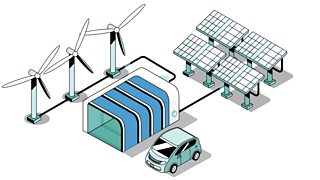But there is another potential reason to develop battery swap stations: to use them as energy storage stations, say Liu and Xue. Due to the variable nature of renewables like solar and wind, which are booming in China, a huge amount of energy storage is needed to ensure the stability of the power grid. EV batteries, including those in battery swap stations, are one way of providing this, says Liu. Battery swap companies could use their batteries to earn the difference in electricity prices between peaks and troughs, he says.
Some battery swap operators are already eyeing up this opportunity, but so far no stations in China or elsewhere are used in this way. It could provide another big benefit though, says Xie: supporting the grid when local distribution grids are knocked out by extreme weather. One hundred battery swap stations would be equivalent to a 50MW energy storage power station, notes one industry report.
Going global
It’s possible that battery swaps may only ever be a relatively niche offering in China, where both EVs and their charging infrastructure are now widespread. But other countries have struggled to adopt EVs, and battery swaps may in fact play their most useful role in countries where EVs are not yet popular, Xie says, especially as more Chinese EV manufacturers bring their products and technology abroad.
Battery swaps could still solve the range anxiety of some in China
Battery swaps are already being explored outside China. India and several other South East Asian countries are developing battery swap technology for scooters and motorbikes, and in 2022 India announced a new battery swap policy to promote the sales of electric cars. In 2023, Taiwan-based battery swap company Gogoro announced a $2.5bn (£1.9bn) partnership with the Indian state of Maharashtra and local supplier Belrise to build smart battery-swapping and energy infrastructure. Kenya similarly announced a partnership with electric vehicle and battery swap company Spiro in 2023. Meanwhile, after trials with Uber in San Francisco in 2021, California battery-swapping start-up Ample now has partnerships to integrate its swap station technology with Netherlands-based carmaker Stellantis and Tokyo’s EV infrastructure.

And battery swaps could still solve the range anxiety of some in China too. Growth in China’s EV market is currently driven by plug-in hybrid models, Yang says, while growth of pure EV sales has slowed significantly – showing that the convenience of energy replenishment is still valued by EV drivers. Both battery swapping and fast charging promote demand for pure electric vehicles. It remains to be seen what the final balance of these two technologies will prove to work best.
As per the Nio slogan, battery swaps can be seen as a sort of “gas station” for EVs. Whether they can ever reach the scale of gas stations, or even of EV recharging stations remains to be seen.
—